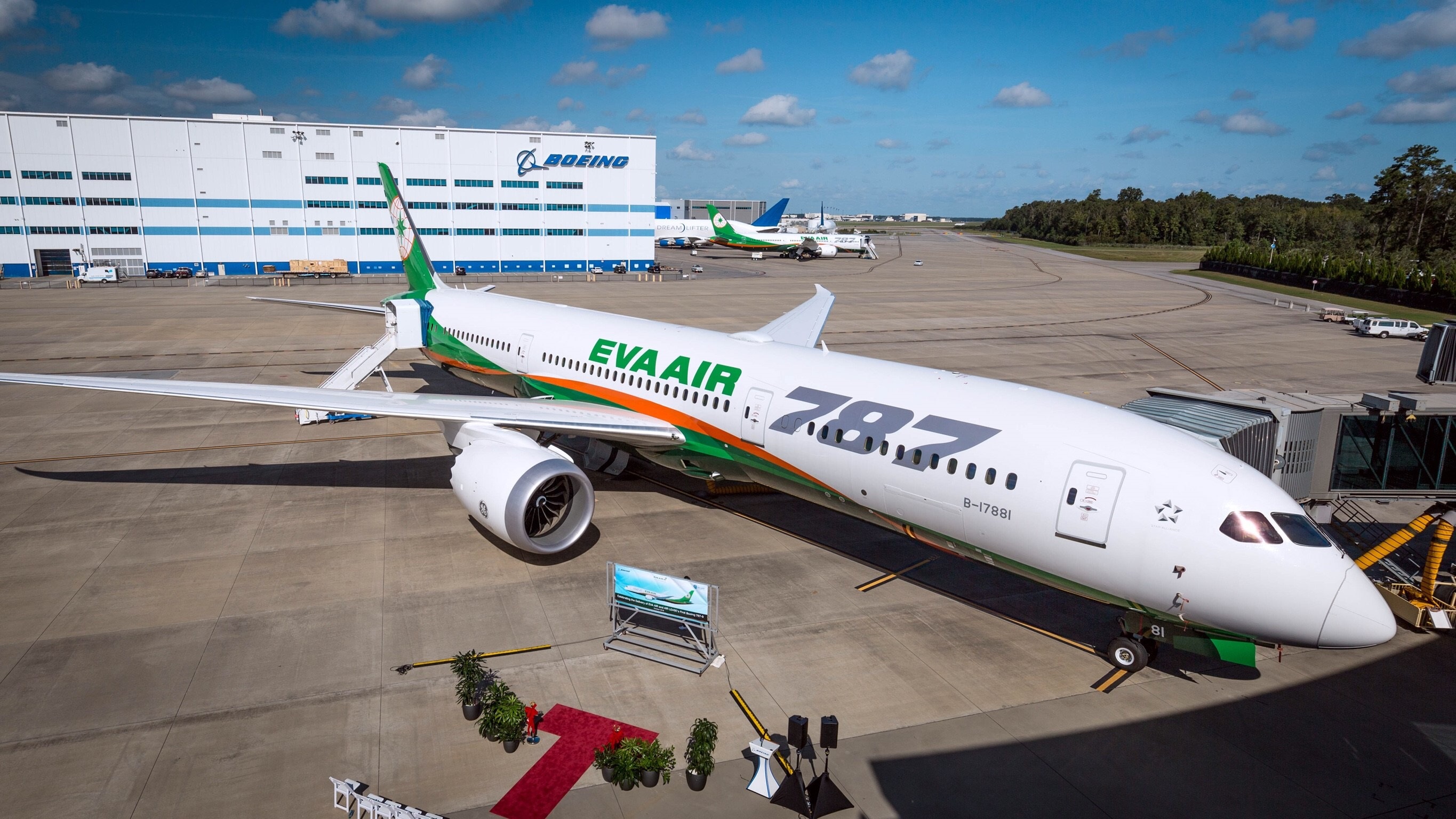EVA Accepts Delivery of Its 1st Boeing 787-9 Dreamliner. Carrier to add three more 787-9s, 20 787-10s.
EVA Air accepted delivery of its first 787-9 Dreamliner, aircraft number B-17881, at Boeing South Carolina on Oct. 2, 2018. EVA Chairman Steve Lin led a delegation to welcome the new aircraft and commemorated the event with a ribbon cutting ceremony. EVA will ferry its newest aircraft to Taiwan and ready it for service.
On Oct. 1, 2018, Boeing Commercial Airplanes President and CEO Kevin McAllister hosted a festive ceremonial dinner where Chairman Lin and ALC Executive Chairman Steve Házy, owner of the new Dreamliner that EVA will be leasing, signed commemorative certificates. The certificates signify a new milestone in the partnerships among the three parties.
“Our introduction of Boeing 787 Dreamliners gives us a younger and more efficient fleet and further upgrades our service quality,” said EVA Chairman Steve Lin. “In addition to giving our passengers the comforts and conveniences of the Boeing Dreamliner’s advanced aviation technologies, we have made great efforts to enhance our cabin service. We will launch new Royal Laurel Class business seats created by Designworks, a BMW company. And we chose Teague, a global design consultancy recognized for work in aviation, to design new Economy Class seats that RECARO, a German manufacturer known for sports car interiors, is producing. We are making these investments to give our passengers better flying experiences and further demonstrate our dedication to five-star airline service.”
EVA is adding 24 Dreamliners to its fleet, including four 787-9s it is beginning to introduce after this delivery and twenty 787-10s to be delivered between the second quarter of 2019 and 2022. The Boeing 787-9 has a range of 7,100 nautical miles fully loaded, the capacity to fly from Taipei to Vancouver, Seattle, Vienna or Brisbane. EVA is configuring its 787-9s for 304 passengers with 26 in Royal Laurel Class and 278 in Economy.
Highlighting its status as the first Boeing 787 to be introduced into service in Taiwan, EVA’s new Dreamliner is distinguished by the addition of the innovative aircraft model’s logo to the livery design. The livery also incorporates powerful green and orange stripes, representing Evergreen Group’s corporate identity colors and suggesting extraordinary flying speed.
Technologies used to build the Boeing 787 Dreamliner make the aircraft more environmentally efficient. It is constructed of lighter composite materials such as carbon fiber and more than 50% of the aircraft’s total weight comes from these materials, including the fuselage, wings and engine blades. Compared to traditional aluminum alloy fuselage construction, these advanced materials significantly decrease the aircraft’s overall weight and likelihood of metal fatigue or corrosion, reducing maintenance costs. Replacing fluorescent tubes with LED lights shrinks power demand by almost half.
GE’s advanced GEnx engines reduce fuel consumption and greenhouse gas emissions by 20%, compared to power systems on traditional wide-body aircraft. The 787-9’s high fuel efficiencies and range capabilities equip EVA to further enhance operational performances.
Boeing also engineered its Dreamliners to enhance cabin comfort. The Boeing 787 is equipped with an advanced air filtration system that improves cabin air. The 787 fuselage is made of a combination of composite materials that make it more airtight. Compared with other commercial jets, the 787’s cabin humidity can be increased as much as three-to-four times, eliminating the drying inflight atmosphere. The aircraft’s cabin pressure can also be controlled to make the altitude feel like the optimal 6,000 ft. instead of the standard 8,000 ft., boosting passengers’ blood-oxygen levels and reducing headaches and fatigue. Newly designed engine housings significantly reduce noise and give passengers quieter, more comfortable inflight environments.
EVA bonded with the Boeing 787 Dreamliner during its early development. Before Boeing began making the aircraft, it chose Evergreen Aviation Technologies Corp. (EGAT) to build four Large Cargo Freighters (LCFs) for transporting the Dreamliner’s composite parts to manufacturing facilities for assembly. Boeing uses the LCFs to carry over-sized parts such as fuselages and wings manufactured in Italy, Japan and other countries to the US for assembly. The LCF made it feasible for Boeing to build the 787. The super-sized freighter also made EGAT a global aircraft maintenance, repair and overhaul leader.
As soon as EVA gets its first Boeing 787-9, it will finalize preparations for putting the plane in service and work with Taiwan’s Civil Aeronautics Administration (CAA) to get it certified. EVA estimates that it will launch the new Dreamliner in early November 2018. It will initially deploy the aircraft on its busy Taipei – Hong Kong route. EVA’s second Dreamliner is expected to be delivered in November 2018 and will be used to extend the airplane’s operations to Osaka and Tokyo. The remaining two Boeing 787-9s are scheduled for delivery in 2019 and EVA will deploy them on major regional routes within Asia and flights to Brisbane, Australia.
About EVA Air:
EVA Air is a Star Alliance member and one of only 11 SKYTRAX-rated 5-Star airlines worldwide. Readers voted it one of Travel + Leisure’s World’s Best “Top 10 International Airlines” and TripAdvisor awarded it top spots in five categories in its annual Travelers’ Choice Awards for Airlines. The carrier was established in 1989 as Taiwan’s first privately owned international airline. It is part of the respected Evergreen Group and a sister company to global container-shipping leader Evergreen Line. It flies a fleet of more than 70 Boeing and Airbus aircraft to over 60 international destinations throughout Asia, Oceania, Europe and North America where gateways are Chicago, Houston, Los Angeles, New York, San Francisco, Seattle, Toronto and Vancouver. Travelers can learn more about EVA and schedule, book and buy tickets at www.evaair.com.




